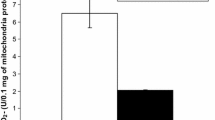Summary
The uptake, distribution and elimination of carbon monoxide (CO) was investigated in experiments with rabbits by analysing samples of expired air, blood and a pneumoperitoneum of nitrogen set the day before.
The partial pressure of CO in a pneumoperitoneum first reaches equilibrium after approx. 15 hours of breathing a constant mixture of CO and air. The excretion of CO from this area also requires more than 10 hours.
The partial pressure of CO in the tissues reaches 64% of that of the air inspired at a CO pressure of 0.212 Torr (CO concentration of 300 ppm); it attains only 47% of the CO partial pressure of the inspired air if the animals breathe a. mixture with 0.708 Torr CO (CO concentration of 1,000 ppm).
The less affinity the hemoglobin of individual animals has for carbon monoxide, the higher the CO partial pressure in the tissues, once diffusion equilibrium has been achieved. This correlation holds also true for different animal species.
It has been proven by experimentation and by application of the law of mass action that the competition between carbon monoxide and oxygen for the receptor hemoglobin also represents an essential factor in the determination of CO partial pressure in the tissues.
Zusammenfassung
In Versuchen an Kaninchen wird die Aufnahme, Verteilung und Abgabe von Kohlenoxid untersucht und zwar durch Analysen von Proben der Ausatmungsluft, des Blutes und eines künstlich angelegten intraperitonealen Stickstoffdepots.
Im Pneumoperitoneum stellt sich während der Beatmung mit konstanten CO-Luftgemischen der Gleichgewichtspartialdruck für CO erst nach etwa 15 Std ein, und auch die Ausscheidung aus dem Depot dauert länger als 10 Std.
Der Gleichgewichtspartialdruck für CO im Gewebe beträgt bei Beatmung mit 0,212 Torr CO (CO-Konzentration = 300 ppm) nur 64% des CO-Partialdrucks in der Einatmungsluft, bei Beatmung mit 0,708 Torr CO (CO-Konzentration = 1000 ppm) sogar nur 47% des CO-Partialdrucks in der Einatmungsluft.
Nach Einstellung des Diffusionsgleichgewichts liegt der CO-Partialdruck im Gewebe bei den einzelnen Tieren um so höher, je geringer die Affinität des Hämoglobins zum Kohlenoxid ist. Diese Beziehung gilt auch für verschiedene Tierspezies.
Experimentell und an Hand des Massenwirkungsgesetzes wird bewiesen, daß die Konkurrenz des Kohlenoxids und des Sauerstoffs um den Receptor Hämoglobin auch für den CO-Partialdruck im Gewebe ein wesentlicher determinierender Faktor ist.
Similar content being viewed by others
Literatur
Bänder, A., u.M. Kiese: Die Bedeutung der Wirkung des Kohlenoxyds auf die Zellatmung für die Kohlenoxydvergiftung. Klin. Wschr.33, 152 (1955).
Bartels, H., u.H. Harms: Sauerstoffdissoziationskurven des Blutes von Säugetieren (Mensch, Kaninchen, Meerschweinchen, Hund, Katze, Schwein, Rind und Schaf). Pflügers Arch. ges. Physiol.268, 334 (1959).
Coburn, R. F., W. S. Blakemore, andR. E. Forster: Endogenous carbon monoxide production in man. J. clin. Invest.42, 1172 (1963).
—,W. J. Williams, andR. E. Forster: Effect of erythrocyte destruction on carbon monoxide production in man. J. clin. Invest.43, 1098 (1964).
Fretwurst, F., u.K. H. Meinecke: Eine neue Methode zur quantitativen Bestimmung des CO-Hämoglobins im Blut. Arch. Toxikol.17, 273 (1959).
Göthert, M., F. Lutz, u.G. Malorny: Kohlenoxydpartialdruck im Pneumoperitoneum von Kaninchen, Meerschweinchen und Ratten in Beziehung zum Kohlenoxydhämoglobin-Gehalt. Naunyn-Schmiedebergs Arch. Pharmak. u. exp. Path.260, 122 (1968).
Jost, W.: Ein physiologisches Diffusionsproblem. Z. Naturforsch.4b, 318 (1949).
Loeschke, H.: Über die Diffusion von Gas in mit Gas untersättigte Lösungen mit Durchrechnung biologischer Beispiele. Z. Naturforsch,11b, 613 (1956).
Malorny, G.: Beeinflussung der Leistungsfähigkeit durch Kohlenoxid. Staub23, 156 (1963).
—,G. Fodor u.H. Pomp: Wirkungen niedriger CO-Konzentrationen auf Spontanmotilität und Fluchtreaktion (mit Kurzfilm). Naunyn-Schmiedebergs Arch. exp. Path. Pharmak.246, 23 (1963).
—, u.H. Schniewind: Über die Diffusion von Kohlendioxyd und Sauerstoff in vivo. Z. Biol.112, 468 (1961).
Rein, H., u.M. Schneider: Einführung in die Physiologie des Menschen, 15. Aufl., S. 192. Berlin-Heidelberg-New York: Springer 1966.
Scholander, P. E.: Analyzer for accurate estimation of respiratory gases in onehalf cubic centimeter samples. J. biol. Chem.167, 235 (1947).
Siegenthaler, P., etG. Hellé: Formation endogène de monoxyde de carbone associeée à la destruction des érythrocytes. Schweiz, med. Wschr.95, 1445 (1965).
Spector, W. S.: Handbook of biological data, p. 271. Philadelphia 1956.
Tobias, C. A., J. H. Lawrence, F. J. W. Roughton, W. S. Root, andM. I. Gregersen: The elimination of carbon monoxide from the human body with reference to the possible conversion of CO to CO2. Amer. J. Physiol.145, 253 (1945).
Author information
Authors and Affiliations
Additional information
Wir danken der Deutschen Forschungsgemeinschaft, Bad Godesberg, für die gewährte Unterstützung.
Rights and permissions
About this article
Cite this article
Göthert, M., Malorny, G. Zur Verteilung von Kohlenoxid zwischen Blut und Gewebe. Arch. Toxikol. 24, 260–270 (1969). https://doi.org/10.1007/BF00577574
Received:
Issue Date:
DOI: https://doi.org/10.1007/BF00577574
Key-Words
- Carbon Monoxide Affinity to Hemoglobin
- Carbon Monoxide in Tissue
- Carbon Monoxide in Expired Air
- Law of Mass Action




